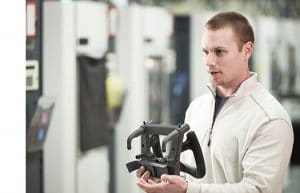Boosting Business with 3D Printing
About thirty years ago, 3D printing emerged as a new technology that could create objects from a digital file using a process known as additive manufacturing. Today, news coverage continues to follow the business boosting benefits it affords.
If you are new to 3D printing, here is how it is done: First, you make a virtual design of an object using a 3D-modeling CAD program to design a new object, or if you would like to make a design file of an existing object, you can use a 3D scanner to copy it. Next, the 3D printer prints the object by applying layer after layer of material to produce the complete object. The material can be anything from clear, rubberlike and biocompatible photopolymers to tough high-performance thermoplastics. It just depends on the application for which the object is created, and the 3D printer used.
how it is done: First, you make a virtual design of an object using a 3D-modeling CAD program to design a new object, or if you would like to make a design file of an existing object, you can use a 3D scanner to copy it. Next, the 3D printer prints the object by applying layer after layer of material to produce the complete object. The material can be anything from clear, rubberlike and biocompatible photopolymers to tough high-performance thermoplastics. It just depends on the application for which the object is created, and the 3D printer used.
The most common business applications involve examples of manufacturers using 3D printing to produce prototypes and parts faster and cheaper than traditional means. This applies to a wide range of industries, including aerospace, defense, automotive, medical and consumer goods. And if cost and time savings weren’t enough, another direct business boosting benefit of 3D printing is innovation. The ability to print product prototypes in-house on a 3D printer, rather than sending them out for fabrication and waiting days or weeks, allows engineers to evaluate and optimize their designs for market-ready production in less time. This leads to another business boosting benefit: faster time to market.
But that’s not all, companies are also using 3D printing to create tools for manufacturing operations, including jigs and fixtures that are used to position, hold, protect and organize components and subassemblies during the multiple stages of the manufacturing process. Therefore, new jigs and fixtures need to be rapidly designed, manufactured and installed to avoid production halts or product defects—and the negative bottom line impact of delayed product releases or recalls.
Traditionally, jigs and fixtures are made in small quantities using metal, wood or plastic using a semi-automated or manual process. This method can take anywhere from one to four weeks to design and build the tools. Additionally, more complex tools may require several cycles of design, prototyping and evaluation to achieve the required performance.
You can avoid the lengthy build time and costs associated with the traditional tool fabrication method by using 3D printing. Using a Fused Deposition Modeling (FDM) 3D printer provides a faster and more accurate method for producing jigs and fixtures. The FDM technology allows for the tools to be designed for optimal performance and ergonomics because it places few constraints on tool configuration. Plus, materials are lightweight compared to metal. However, don’t confuse lightweight with being less durable. FDM technology uses durable, production-grade materials. And like the prototype and part production example above, engineers can easily evaluate how tools are performing, make rapid design adjustments, and produce optimized versions quickly.
With its many business boosting benefits, 3D printing is not only a time-tested manufacturing option for so many practical industry applications that can reduce costs and save time. It’s also an opportunity for bringing greater innovation to your teams. How are you using 3D printing to help your organization boost business?
Related Articles
Efficiency, Flexability & The Factory of the Future with 3D Printing

 Blog
Blog